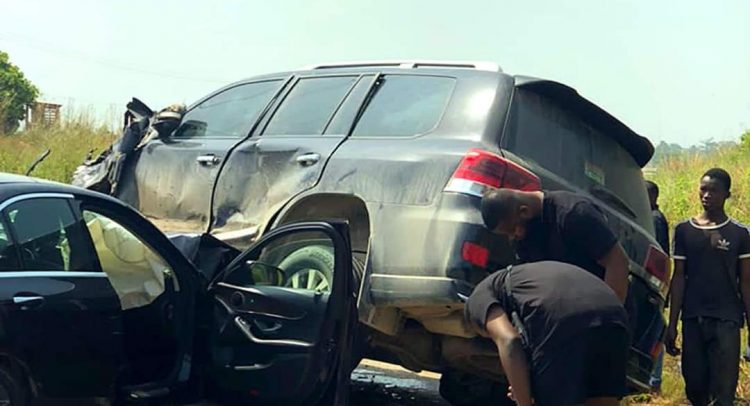
Two months ago, I wrote an article titled, “Road accidents are a public health threat to Ghana.” The article highlighted the negative impact of incessant road accidents on the socio-economic development of Ghana.
Shortly after I raised the red flag over the needless deaths on our roads, the accident that killed the 16 youth of the Saviour Church of Ghana occurred on the Nkawkaw-Kumasi stretch. This was followed by a helicopter crash in which eight of our compatriots died in the service of their country.
Is Ghana under a curse?
I have been compelled to comment on the road accident menace again because, every day and every hour deadly road accidents are occurring, as if Ghana is under some curses. On August 25, an accident at Nkawkaw- Nkwanda road killed close to 20 people, and the only survivor was a little child.
Similarly on August 27, an citizen journalist reported how an articulated truck collided with a Sprinter bus on the same Accra-Kumasi Road and killed all passengers on board. The citizen journalist shared pictures of the accidents on social media, to authenticate the report. He pleaded with state authorities to wake up from their slumber and stop the carnage on the Accra-Kumasi Road.
In the coverage of breaking news like road accidents and natural disasters citizen journalists and bloggers are outcompeting mainstream media and traditional journalists. Previously mainstream media and trained journalists reported road accidents, but now with a smartphone and data, citizen journalists are instantly reporting accidents across the country. The phenomenon of eyewitness reporting is giving us a comprehensive picture of the negative threat road accidents pose to Ghana’s socio-economic development.
Causes of accidents
Ghana is prone to road accidents due to a combination of factors including poor road conditions, driver indiscipline (speeding, drunk driving, fatigue), faulty or overloaded vehicles, and inadequate infrastructure like poor signage and lighting. Other factors include weak enforcement of regulations and high volume of vehicles.
These socio-economic factors often contribute to driver stress which leads to frequent and deadly road incidents. I think road accidents constitute a national disaster, which needs an emergency policy response.
For several decades road accidents have been a major drawback to Ghana’s population decrease. In the first quarter of 2025 a whopping 1,504 deaths were recorded and represents a 21.6% increase from the same period in 2024. In all, there were 7,289 road crashes, 8,300 injuries, and 1,301 pedestrian knockdowns in the first six months of 2025.
Averages indicate that eight lives are lost daily, along with 40 crashes, 46 daily injuries, and 69 vehicles involved in accidents nationwide, according to data from the Ghana Road Safety Authority and the Motto Traffic Unit of the Ghana Police Service. In fact, many people, including yours truly are now afraid to travel on the Accra-Kumasi, Kumasi-Tamale and the Accra- Takoradi roads.
Deadly roads in Ghana
Seven roads have been marked as the most dangerous highways in the country due to the number of recorded road accidents on these roads. According to the National Roads and Safety Commission report (2004-2011). The seven roads include:
- Accra-Kumasi: The Accra-Kumasi Road is the most dangerous in Ghana due to a combination of high-volume commercial traffic, poor road conditions, single-lane carriageways, and widespread driver recklessness involving speeding and illegal overtaking. The road distance between Accra and Kumasi is approximately 249 to 251 kilometers. It is the deadliest of all the roads in Ghana.
- Accra–Cape Coast: This road is 145 kilometres’ long via the N1 Highway. Within eight years, there were 6,104 road crashes on that stretch with 7,465 casualties. This means that consistently for eight years, two people died or got injured in road crashes on that stretch every day.
- Aflao–Accra: This road is 187 kilometre’s off the N1 highway and has recorded 3,919 road accidents in the year under review. A total of 6,826 persons got injured or died from the incidents.
- Tema–Hohoe: This is 191 kilometres’ long. This stretch recorded 1,965 road crashes with 4,393 people being casualties. This makes it an average of two people getting injured or dying from each reported accident on the stretch via the N2 highway.
- Kumasi–Techiman: This is a 126-kilometre stretch using the N10 highway. In eight years, 1,702 road crashes were officially recorded on this stretch. This resulted in 3,481 casualties, indicating that each accident left about two people dead or injured.
- Kintampo–Tamale: The stretch is 196 kilometres, from where 939 road crashes occurred within the years under review via the N10 highway. A total of 523 casualties.
- Takoradi–Elubo: The 130-kilometre road via the N1 highway has seen 839 road crashes within 8 years and 1,425 casualties as a result.
- Tamale–Bolga: On this stretch, 780 motor accidents were recorded with 1,696 casualties. The stretch is located on the N 10 highway and is approximately 160 kilometres long.
Driver-Related Factors
The driver related causes of accidents include:
- Indiscipline and Recklessness: Over-speeding, careless driving, drunk driving, and aggressive maneuvers like dangerous overtaking are major causes of accidents.
- Fatigue: Drivers, particularly those working under “work-and-pay” systems, often face stress and fatigue, leading to reduced judgment and increased accident risk. Besides, drivers of heavy-duty vehicles, especially those from Burkina Faso, Mali and Niger demonstrate very little judgement when they pack and move their vehicles.
- Inadequate driver Training: A lack of comprehensive driver education and the failure to understand traffic signs contribute to violations of the road code. How did these drivers obtain licenses to drive?
- Corruption: The practice of bribing enforcement personnel to avoid penalties for infringements undermines traffic laws.
Vehicle-related factors
Many road accidents have been attributed to the poor conditions of vehicles.
Poor Vehicle Maintenance: Many vehicles are poorly maintained, leading to mechanical failures like brake failure, steering lock issues and tire bursts. In fact, more than half of all vehicles on our roads are not road worthy. Most of them are moving on torn tires and lack traffic indicators to signal where they are turning.
The most serious is that the brake lights of many vehicles are not working, so drivers following them have to be alert. Yet, all the faulty vehicles have road worthy stickers. This implies that such drivers do not take their vehicle to the Driver and Vehicle licensing Authority (DVLA) for physical examination.
Overloading: Overloading is the biggest threat to our safety on the roads. Overloaded vehicles, particularly commercial ones, increase the risk of instability and accidents. Our road safety enforcement agencies see these long vehicles overloaded to unreasonable levels, yet they signal the vehicles to move on.
No serious country will allow the kind of overloaded vehicles on its roads. Not even Niger, Burkina Faso and Mali, where most of the long vehicles originate will allow what is happening on our roads.
Road and infrastructure factors
Poor road conditions: Undoubtedly, the nature of our roads is a serious economic challenge, which comes at the cost of human lives. Potholes, damaged roads, and poorly constructed or maintained roads are directly contributing to accidents by forcing drivers to lose control.
Inadequate signage and lighting: Related to our terrible road networks is a lack of sufficient road signs, streetlights, and clear road markings. This shortcoming makes driving more hazardous and deadly, especially during nights, when most of the long vehicles often move.
Congestion: There is no doubt that our roads are congested. Motor vehicle registration in Ghana is increasing rapidly as the population grows. Vehicle registration data indicates that vehicles registered vehicles reached 3.47 million in 2024, with 3.2 million registered by 2022.
This means Ghana has more vehicles than our roads can contain. Naturally, road congestion often results in self-induced fatigue and aggressive driving; as drivers overspeed to make up for lost time. This is what often leads to wrong overtaking and over speeding,
Institutional and systemic issues
Weak Enforcement: It is a known fact that our country has a weak law enforcement regime in all areas of national endeavour, especially in the road and transportation sector. The weak enforcement of rules and regulations is the result of systemic corruption, nepotism, favouratism and the “above the law syndrome.” The weak enforcement of traffic regulations by police and other authorities allows dangerous behaviours and violations to persist.
Reckless and careless drivers are easily left the hook because of bribery and “whom they know” factor. A few years ago, a young driver lost his life when he drove into a wrongly packed long and overloaded vehicle heading for Burkina Faso. It was an obvious case of the driver to be prosecuted, yet the officer at the Tesano Police Station who handled the case failed to prosecute the driver.
The feet dragging by the police officer was enough to discourage the mother of the dead driver to stop following the case. Unfortunately, the young driver was the only child of the mother. The mother told yours truly that she had no option than to leave the case into the hands of the God of justice.
Policy interventions
In view of the social and economic consequences of road accidents to families and the economy, the government needs to make critical policy interventions, with budgetary implications. Firstly, there is an urgent need for the government to continue with the dualization of our major roads-Accra-Takoradi, Accra-Kumasi, Accra-Aflao, Kumasi-Tamale and Tamale-Bolgatanga roads.
Also, the bypasses started by the past government should be funded and completed to ease vehicular congestion at Anyinam and Konongo. Besides, the government needs to renovate all damaged roads to improve easy movement.
Secondly, one of the flaws with our road management is poor demarcations of the road. The lack of markings on the roads makes it difficult for drivers to remain in one lane. Thus, drivers often swing from lane to lane, which causes most avoidable accidents.
Thirdly, the government should empower all road safety stakeholders (NRSC, DVLA) to invent scientific technologies on the roads mainly to alarm drivers, passengers, and pedestrians about avoidable accidents.
As indicated earlier, road accidents in Ghana have severe socio-economic and health implications, causing loss of lives, serious injuries, and significant economic strain on families and the country.
REFERENCES
Boamah SP. 2013. The hidden cause of road accidents and deaths. Retrieved on 28th March 2020 from: https://www.ghanaweb.com/GhanaHomePage/features/The-hidden-cause-of-road-accidents-and-deaths-282863.
Kontoh A. 2004. Ghana’s Roads? Which Way? Retrieved on 28th March 2020 from: https://www.ghanaweb.com/GhanaHomePage/features/Ghana-s-Roads-Which-Way-54862.
Koranteng, KA. 2018. Ghana’s Deadly Roads. FairPlanet. Retrieved on 28th March 2020 from: https://www.fairplanet.org/story/ghanas-deadly-roads/.
The post DEVELOPMENT DISCOURSE WITH AMOS SAFO: The economic and social consequences of road accidents appeared first on The Business & Financial Times.
Read Full Story















Facebook
Twitter
Pinterest
Instagram
Google+
YouTube
LinkedIn
RSS